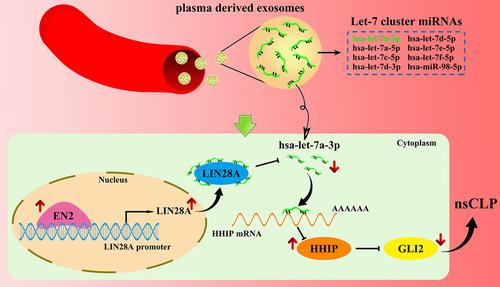当前位置:
X-MOL 学术
›
Ann. N. Y. Acad. Sci.
›
论文详情
Our official English website, www.x-mol.net, welcomes your feedback! (Note: you will need to create a separate account there.)
Identification by RNA-Seq of let-7 clusters as prenatal biomarkers for nonsyndromic cleft lip with palate
Annals of the New York Academy of Sciences ( IF 5.2 ) Pub Date : 2022-07-19 , DOI: 10.1111/nyas.14868 Shanshan Jia 1 , Qiang Zhang 1, 2 , Yu Wang 1, 3 , Xiaowei Wei 1 , Hui Gu 1 , Dan Liu 1 , Wei Ma 1 , Yiwen He 1 , Wenting Luo 1 , Zhengwei Yuan 1
Annals of the New York Academy of Sciences ( IF 5.2 ) Pub Date : 2022-07-19 , DOI: 10.1111/nyas.14868 Shanshan Jia 1 , Qiang Zhang 1, 2 , Yu Wang 1, 3 , Xiaowei Wei 1 , Hui Gu 1 , Dan Liu 1 , Wei Ma 1 , Yiwen He 1 , Wenting Luo 1 , Zhengwei Yuan 1
Affiliation

|
Nonsyndromic cleft lip with palate (nsCLP) is a common congenital malformation; however, early prenatal diagnosis is challenging and pathogenesis remains unclear. The purpose of this study was to determine the diagnostic potential of miRNAs in plasma-derived exosomes and whole plasma of pregnant women to identify nsCLP and an underlying mechanism. Combined RNA sequencing analysis was performed on samples from plasma exosomes and whole plasma of pregnant women carrying normal fetuses or fetuses with nsCLP in an ongoing birth cohort, in addition to lip samples from nsCLP fetuses and healthy controls. Eight let-7 cluster miRNAs (hsa-let-7a-3p, hsa-let-7a-5p, hsa-let-7c-5p, hsa-let-7d-3p, hsa-let-7d-5p, hsa-let-7e-5p, hsa-let-7f-5p, and hsa-miR-98-5p) in plasma exosomes from pregnant women provided higher sensitivity/specificity for diagnosing fetal nsCLP than those in plasma. Area under the receiver operating characteristic curve value of the eight miRNAs from plasma exosomes was 0.992. Among them, hsa-let-7a-3p showed better diagnostic capability and was downregulated in nsCLP fetal lip tissues. Upstream and downstream target genes of hsa-let-7a-3p were screened and confirmed. Our work highlights the potential clinical application value of let-7 clusters in predicting nsCLP and associates as a new regulatory axis (EN2–LIN28A–hsa-let-7a-3p–HHIP–GLI2) with human nsCLP pathogenesis.
中文翻译:

通过 RNA-Seq 鉴定 let-7 簇作为非综合征型唇腭裂的产前生物标志物
非综合征性唇腭裂 (nsCLP) 是一种常见的先天性畸形;然而,早期产前诊断具有挑战性,发病机制仍不清楚。本研究的目的是确定 miRNA 在血浆来源的外泌体和孕妇全血浆中的诊断潜力,以识别 nsCLP 和潜在机制。除了来自 nsCLP 胎儿和健康对照的唇部样本外,还对来自怀有正常胎儿或患有 nsCLP 胎儿的孕妇的血浆外泌体和全血浆样本进行了联合 RNA 测序分析。八个 let-7 簇 miRNA(hsa-let-7a-3p、hsa-let-7a-5p、hsa-let-7c-5p、hsa-let-7d-3p、hsa-let-7d-5p、hsa-let -7e-5p, hsa-let-7f-5p, 和 hsa-miR-98-5p)与血浆相比,孕妇血浆外泌体对诊断胎儿 nsCLP 的敏感性/特异性更高。来自血浆外泌体的 8 种 miRNA 的受试者工作特征曲线下面积为 0.992。其中,hsa-let-7a-3p 显示出更好的诊断能力,并且在 nsCLP 胎唇组织中被下调。筛选并确认hsa-let-7a-3p的上下游靶基因。我们的工作强调了 let-7 簇在预测 nsCLP 中的潜在临床应用价值,并将其作为新的调节轴 (EN2–LIN28A–hsa-let-7a-3p–HHIP–GLI2) 与人类 nsCLP 发病机制相关联。hsa-let-7a-3p 显示出更好的诊断能力,并且在 nsCLP 胎儿唇组织中被下调。筛选并确认hsa-let-7a-3p的上下游靶基因。我们的工作强调了 let-7 簇在预测 nsCLP 中的潜在临床应用价值,并将其作为新的调节轴 (EN2–LIN28A–hsa-let-7a-3p–HHIP–GLI2) 与人类 nsCLP 发病机制相关联。hsa-let-7a-3p 显示出更好的诊断能力,并且在 nsCLP 胎儿唇组织中被下调。筛选并确认hsa-let-7a-3p的上下游靶基因。我们的工作强调了 let-7 簇在预测 nsCLP 中的潜在临床应用价值,并将其作为新的调节轴 (EN2–LIN28A–hsa-let-7a-3p–HHIP–GLI2) 与人类 nsCLP 发病机制相关联。
更新日期:2022-07-19
中文翻译:

通过 RNA-Seq 鉴定 let-7 簇作为非综合征型唇腭裂的产前生物标志物
非综合征性唇腭裂 (nsCLP) 是一种常见的先天性畸形;然而,早期产前诊断具有挑战性,发病机制仍不清楚。本研究的目的是确定 miRNA 在血浆来源的外泌体和孕妇全血浆中的诊断潜力,以识别 nsCLP 和潜在机制。除了来自 nsCLP 胎儿和健康对照的唇部样本外,还对来自怀有正常胎儿或患有 nsCLP 胎儿的孕妇的血浆外泌体和全血浆样本进行了联合 RNA 测序分析。八个 let-7 簇 miRNA(hsa-let-7a-3p、hsa-let-7a-5p、hsa-let-7c-5p、hsa-let-7d-3p、hsa-let-7d-5p、hsa-let -7e-5p, hsa-let-7f-5p, 和 hsa-miR-98-5p)与血浆相比,孕妇血浆外泌体对诊断胎儿 nsCLP 的敏感性/特异性更高。来自血浆外泌体的 8 种 miRNA 的受试者工作特征曲线下面积为 0.992。其中,hsa-let-7a-3p 显示出更好的诊断能力,并且在 nsCLP 胎唇组织中被下调。筛选并确认hsa-let-7a-3p的上下游靶基因。我们的工作强调了 let-7 簇在预测 nsCLP 中的潜在临床应用价值,并将其作为新的调节轴 (EN2–LIN28A–hsa-let-7a-3p–HHIP–GLI2) 与人类 nsCLP 发病机制相关联。hsa-let-7a-3p 显示出更好的诊断能力,并且在 nsCLP 胎儿唇组织中被下调。筛选并确认hsa-let-7a-3p的上下游靶基因。我们的工作强调了 let-7 簇在预测 nsCLP 中的潜在临床应用价值,并将其作为新的调节轴 (EN2–LIN28A–hsa-let-7a-3p–HHIP–GLI2) 与人类 nsCLP 发病机制相关联。hsa-let-7a-3p 显示出更好的诊断能力,并且在 nsCLP 胎儿唇组织中被下调。筛选并确认hsa-let-7a-3p的上下游靶基因。我们的工作强调了 let-7 簇在预测 nsCLP 中的潜在临床应用价值,并将其作为新的调节轴 (EN2–LIN28A–hsa-let-7a-3p–HHIP–GLI2) 与人类 nsCLP 发病机制相关联。



























 京公网安备 11010802027423号
京公网安备 11010802027423号